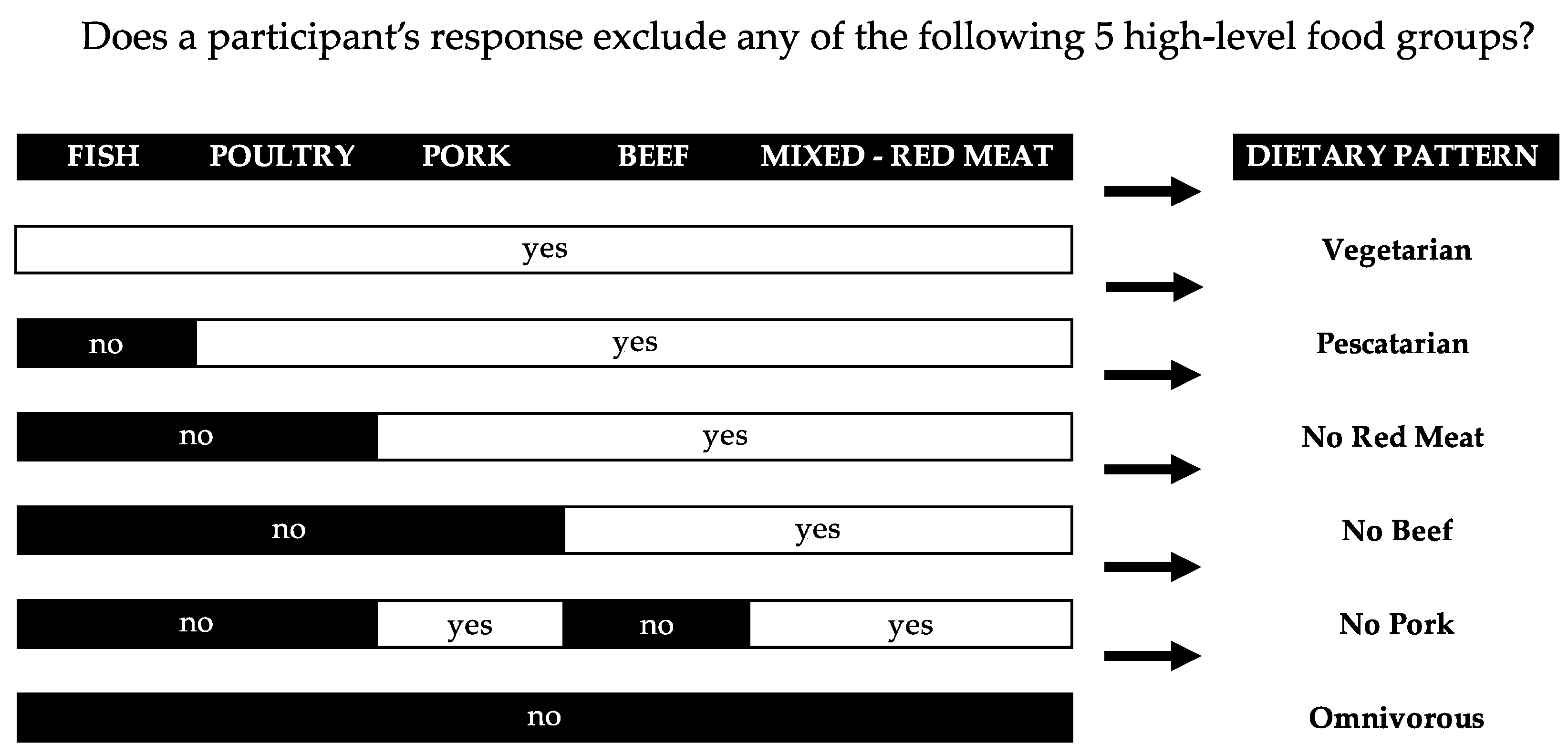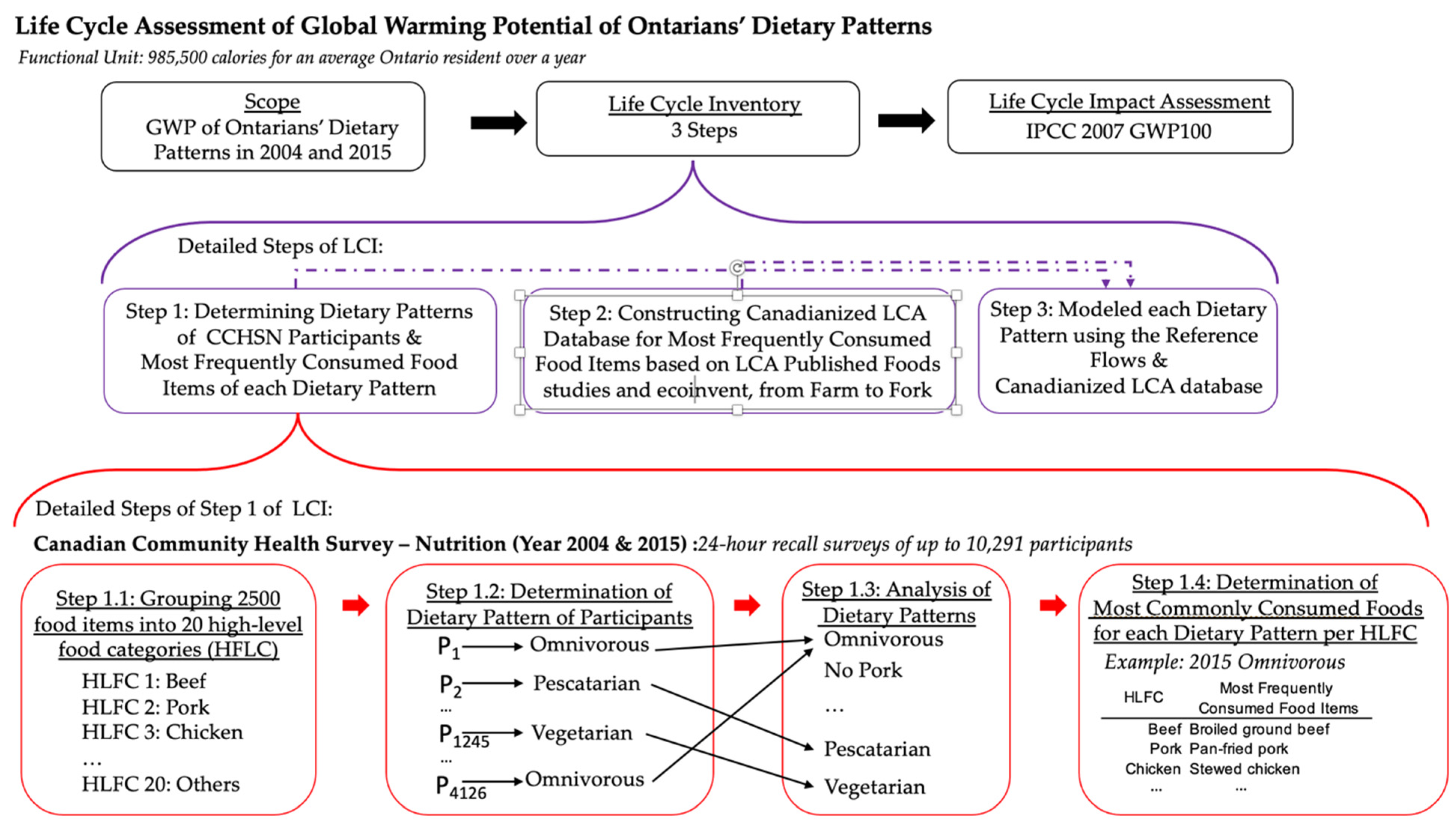The aim of this study was to: (i) compare and evaluate the changes in the GWP of representative DPs from 2004 to 2015 in Ontario, Canada; and (ii) to identify the food drivers of the GWP over this period, with the purpose of providing recommendations on what needs to shift in DPs to achieve climate change goals.
Ontarians’ meat consumption changed from 2004 to 2015; specifically, red meat consumption decreased by up to 32%. Beef consumption decreased by 20%, which may have been a result of beef prices increasing almost twofold between 2004 and 2015 [
38]. Decreasing beef consumption also occurred across Canada [
39]. The price of pork only increased by 28%, and pork consumption only went down by 3% [
38]. In contrast, poultry, fish, and egg consumption increased by 18 to 31%. Poultry and salmon prices increased by up to 43% [
38]. Fish consumption in Ontario increased by 28% from 2004 to 2015, but decreased by 10% across Canada [
39]; however, salmon consumption in Canada increased by 32% [
36,
40,
41]. Increased fish consumption was evident in all DPs, except the Vegetarian DP. The change in meat consumption could therefore be a result of both prices and health concerns, where poultry and fish, in particular, are seen to be healthier than red meat [
42].
There was a reduction in GWP from 2004 to 2015 for all DPs except Pescatarian and No Beef. In contrast, Hjorth et al. [
12] found almost no change (i.e., 3% reduction) in average Swedish dietary GWP per capita from the year 1996 to the year 2016. Gill et al. [
13] showed a high increase in the per capita GWP of daily food consumption (2.5 kg CO
2e) in Brazil, due to increasing consumption of meat, particularly red meat.
Nevertheless, the rank order of GWP of DP from highest to lowest remained the same, with DPs that contained high amounts of red meat having the highest GWP (No Pork, Omnivorous). DPs without red meat had the lowest GWP (No Red Meat, Vegetarian). The Pescatarian DP had the third-highest GWP, and had a higher GWP in 2015, due to increased fish consumption.
4.1. Implications of Changing Dietary Patterns
Although the per capita GWP of DPs decreased by 10% from 2004 to 2015, Ontario’s population has increased by 11%; therefore, the total DP-based GWP of Ontarians remains the same (
Table S12). Therefore, to meet Ontario’s climate targets, the per capita GWP of DP needs to decrease substantially. This becomes more important once Ontario’s population projections are considered for the next 25 years. It is estimated that the population will grow by 32% [
43]. If the GWP of food consumption per capita remains the same, then Ontarians’ total food consumption GWP will increase by 32%. There may be several opportunities to reduce GWP.
Red meat-based DPs are still highly popular, making up almost two-thirds of the DPs in Ontario. In particular, beef and mixed red meat have high GWP, and reducing the amount of red meat in a DP, without eliminating it, was found to lower the GWP of DPs with red meat in Ontario [
17]. It seems that reduced beef consumption was driven by large increases in the price of Canadian beef from 2004 to 2015, therefore increasing prices or putting carbon taxes could further reduce demand for beef. There could also be strategies that aim to get consumers to voluntarily reduce beef and red meat consumption, but this type of advanced messaging should also target consumption of other foods with relatively high GWP, such as certain types of seafood (e.g., shrimp) [
30,
44]. Additionally, the health benefits of red meat reduction could be emphasized.
Another opportunity is to find strategies to reduce the current average energy intake, estimated at 2700 kcal/capita/day, to the average recommended energy intake of 2300 kcal/capita/day (weighted average based on Ontario population demographics [
45]. Much of the Ontario population is overweight or obese (57%) [
46]. If Ontarians lowered their energy intake to recommended levels, even without changing any other consumption habits, the GWP of all DPs would decrease by 14% (
Figure S1). Obtaining recommended energy intake would have positive impacts not only on the environment but also on Ontarians’ health by reducing excess calories that lead to increased body mass and associated non-communicable diseases. However, it has always been extremely challenging to get individuals to change their eating habits due to the influence of nutrition environments [
47], which reflect consumer interactions with food outlets, such as restaurants or grocery stores, and their social environment, including family and social influencers [
47]. For example, for low-income consumers, dietary choices are significantly impacted by cost compared to other factors [
48,
49]. Interventions, such as taxation, banning unhealthy food, and environmental interventions (i.e., changing the physical environment and food positionality or provision of information and food labeling), have been shown to change dietary choices [
50,
51]. Furthermore, retail food environments such as grocery stores can be assessed using a variety of assessment tools [
52,
53] to examine whether retail store characteristics support sustainable and healthy food choices. These tools focus on the availability, price, and quality of healthy and sustainable food choices, which are all significant factors impacting DPs.
A final opportunity for reducing the GWP of DPs is to reduce Ontarians’ protein intake, which has remained almost twice the recommended level of 51 g/capita/day, except for vegetarians (
Figure S2). Similar excessive protein intake has also been observed across Canada [
54]. Excessive protein intake might be due to consumers not accounting for protein in non-meat products, such as milk and cheese. Reducing protein intake from red-meat diets would reduce the GWP of these DPs because animal-based protein sources tend to have the highest GWP [
17]. Although there was a 16% and 32% increase in pulses and nuts/seeds consumption by Ontarians, respectively, these plant-based proteins still make up only 15% of the total protein-based foods by mass. Since they have a much lower GWP (e.g., 0.016 kg/g protein compared to beef at 0.15 kg/g protein), consuming more of these protein sources in any DP, including the Vegetarian DP, could potentially reduce the GWP further.
Similar to reducing energy intake, reducing protein consumption could be challenging as it relates to the nutrition environment and food literacy, and is currently being driven by fad diets, such as Paleo and Keto diets [
55,
56]. The current ratio of animal-to-plant protein is around 70:30, compared to the ratio of 60:40 observed in European countries [
57]. These ratios are classified as high-animal protein, and a 40:60 animal-to-plant protein ratio is recommended by some studies [
3,
57]. Although pulses, poultry, and eggs can be used to substitute animal protein sources that have higher environmental and health impacts [
31,
58], making these shifts is challenging, again due to the consumer nutrition environment. High consumption of animal-based proteins is also associated with higher health risks and non-communicable diseases [
42], while plant proteins have higher health benefits [
58,
59]; therefore, reducing animal-based proteins could be more sustainable from a health and planetary perspective.
4.2. Limitations and Future Work
The goal of this study was to understand the GWP of different DPs, based on realistic and representative food intake. However, the DPs were based on food intake for only one day, so it does not necessarily show individuals’ usual intake over time, e.g., it does not capture the day to day, weekday to weekend, or season to season differences in an individual’s consumption; instead, it is a representation of the population average. Furthermore, self-reported surveys are known for underestimating energy intake [
28]. To overcome this issue, all data were adjusted to a realistic energy intake of 2700 kcal/capita/day. This study also conducted a sensitivity analysis using an alternate approach to adjusting calories due to under-reporting, and this showed that the overall trends in GWP of different DPs do not change. In addition, formulating DPs based on most frequently consumed foods can result in under or over estimation of the nutritional content of food categories. For example, in the milk category, the weighted calorie average of different milk types (e.g., 1%, 2%, 3.25%, and others) resulted in 3% fewer calories compared to the calories based on assuming all the milk consumed was 2% milk. Nevertheless, some simplification is needed when dealing with a large number of foods, and when working with limited life cycle inventories, which may only exist for some foods. This is an issue for all LCAs of DPs, and more work is needed to improve on forming representative DPs.
The chosen system boundary, which is cradle to consumption, excluded some stages, such as waste management across the supply chain, storage at retail, and refrigeration across the supply chain. Future work should try to include these stages and consider the effect of the cold chain, which could have considerable environmental implications [
60,
61].
There are also limitations related to the life cycle inventory for Canadian-specific foods. Data for high-carbon foods, such as fish, were limited. We modeled salmon as being aquaculture-sourced, based on available data, and canned, as this was the most frequently consumed fish, but this life cycle inventory had large uncertainties. Although the results of sensitivity analysis considering these factors showed that the magnitude of the 10-year changes in GWP of Pescatarian DP did not change substantially (
Table 7), more information is required on the type of fish being consumed, such as how it is transported, how long it is frozen and stored, etc. This is particularly important because fish is one type of food that can be good for health but comes with high environmental impacts [
30]. Similarly, data for various production methods for some food items were limited. For example, we modeled tomatoes as being grown in heated greenhouses due to limited data availability of field-grown tomatoes. This probably resulted in overestimating the GWP of tomatoes due to the high-carbon intensity of heated greenhouses [
62]. Similarly, we did not model the organic production of any item due to a lack of data availability. However, organic agricultural production constitutes only 1.8% of total agricultural production in Canada [
63]; therefore, we do not expect the lack of organic production data to impact the results of this study.
This study only evaluated GWP as environmental impact because the life cycle inventory did not include indicators to calculate other impacts for foods produced and consumed in Canada. Evaluating various environmental impacts simultaneously is important to consider trade-offs. For example, some food products can have high GWP but low water impacts (e.g., greenhouse tomatoes) [
62], and pork has relatively lower GWP than beef but similar acidification and eutrophication levels [
31].
In order to conduct more comprehensive studies, more detailed information on Canadian LCA data for agriculture and various production methods (e.g., organic, greenhouse, etc.) is needed. This is an important area of future work for LCA studies of food consumption and DPs. For example, information on production methods (organic, greenhouse), the origin of consumed foods (geography), and processing type of foods (frozen, fresh, and canned) were not modeled.
This study showed which foods were the drivers of high GWP, specifically high meat consumption. However, few studies provide insights on what socio-demographic-cultural factors lead to high meat consumption. Answering these questions can allow the development of more nuanced approaches to shift diets to be more sustainable.










